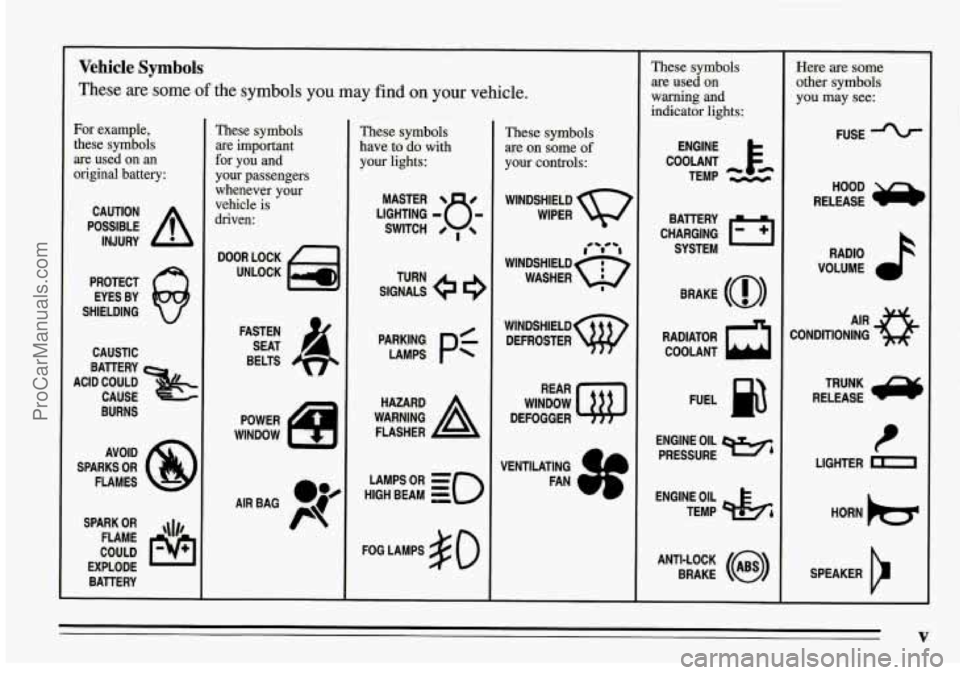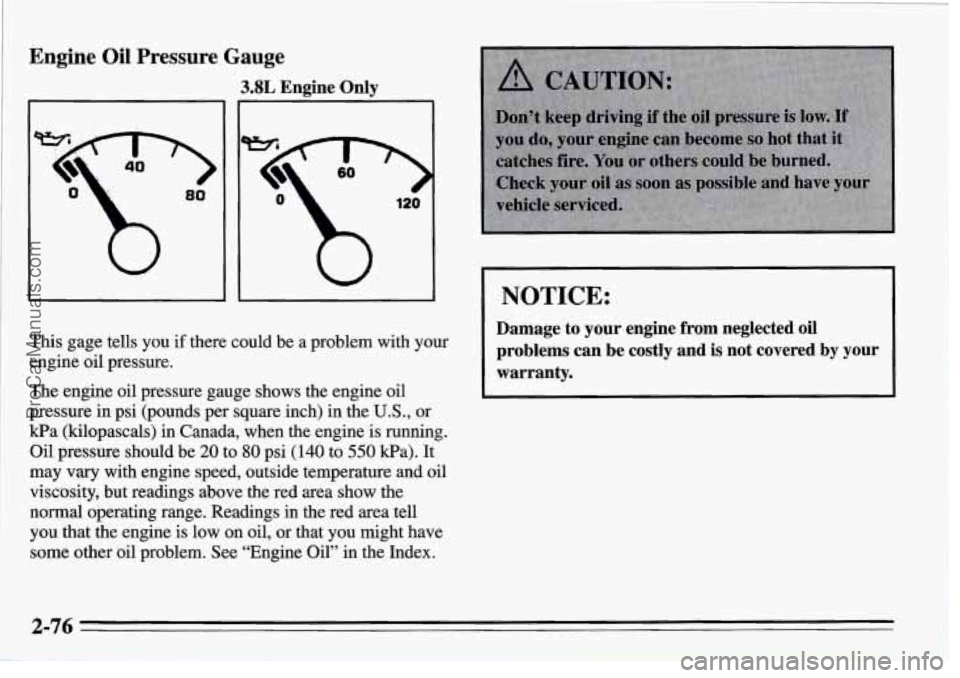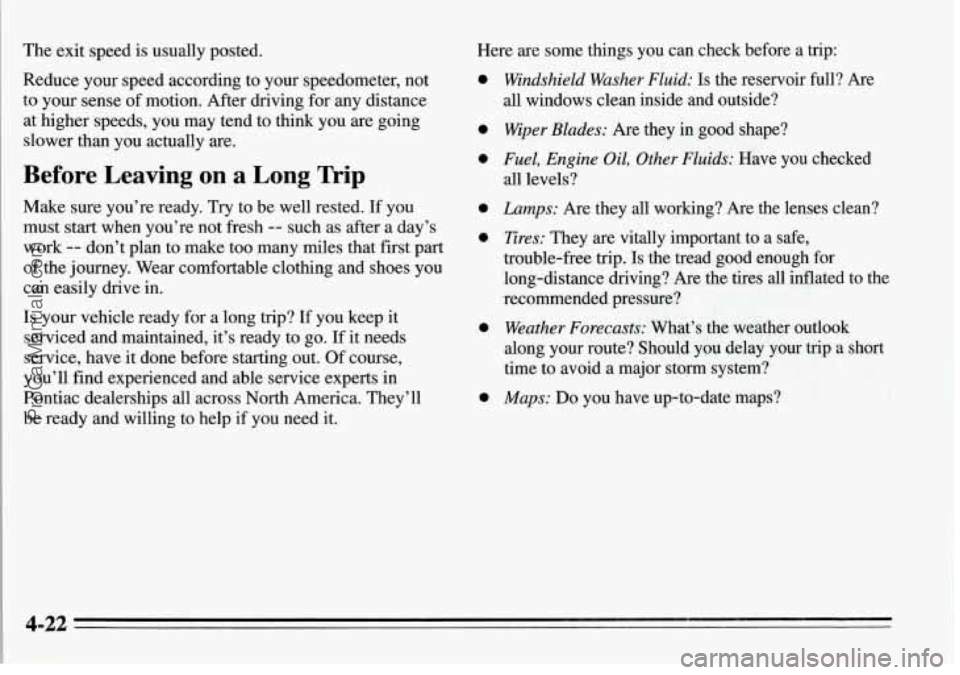engine oil PONTIAC FIREBIRD 1995 Owners Manual
[x] Cancel search | Manufacturer: PONTIAC, Model Year: 1995, Model line: FIREBIRD, Model: PONTIAC FIREBIRD 1995Pages: 386, PDF Size: 19.66 MB
Page 6 of 386

Vehicle Symbols
These are some of the symbols you may find on your vehicle.
For example, these symbols
are used on an
original battery:
POSSIBLE A
CAUTION
INJURY
PROTECT EYES BY
SHIELDING
CAUSTIC
BURNS
AVOID
SPARKS
OR
FLAMES
SPARK OR ,\I/,
COULD FLAME
EXPLODE BAllERY
These symbols
are important
for you and
your passengers
whenever your
vehicle is
driven:
FASTEN SEAT 4
BELTS
POWER
WINDOW
These symbols
have to
do with
your lights:
SIGNALS e
TURN
pAE: pf
HIGH LAMPSoR BEAM = =o
FOG LAMPS $0
These symbols are on some
of
your controls:
WINDSHIELD
WIPER
i ‘t’ i
WINDSHIELD Q
WASHER I
WINDSHIELD
DEFROSTER
WINDOW
DEFOGGER
VENTILATING FAN
These symbols
are used on
warning and
indicator lights:
COOLANT F*
TEMP --
ENGINE
CHARGING 1-1
BATTERY
SYSTEM
BRAKE (0)
RADIATOR COOLANT
a
FUEL
ENGINE OIL
PRESSURE
9%
TEMP OIL &
ANTI-LOCK (a)
BRAKE
-
Here are some
other symbols
you may see:
FUSE
RAM0 h
VOLUME
CONDITIONING AIR 43
RELEASE a
LIGHTER m
SPEAKER
b
V
ProCarManuals.com
Page 69 of 386

To use the coolant heater:
1. Turn off the engine. NOTICE:
2. Open the hood and unwrap the electrical cord.
3. Plug it into a normal, grounded 110-volt outlet.
2-22
After you’ve used the coolant heater, be sure to
store the cord as it was before to keep
it away
from moving engine parts. If you don’t, it could
be damaged.
I
How long should you keep the coolant heater plugged in? The answer depends on the weather, the kind of oil
you have, and some other things. Instead of trying to list
everything here, we ask that you contact your Pontiac
dealer in the area where you’ll be parking your vehicle.
The dealer can give
you the best advice for that
particular area.
ProCarManuals.com
Page 123 of 386

Enghe Oil Pressure Gauge
3.8L Engine Only
This gage tells you if there could be a problem with your
engine oil pressure.
The engine oil pressure gauge shows the engine oil
pressure in psi (pounds per square inch) in the
U.S., or
kPa (kilopascals) in Canada, when the engine is running.
Oil pressure should be
20 to 80 psi (140 to 550 kPa). It
may
vary with engine speed, outside temperature and oil
viscosity, but readings above the red area show the
normal operating range. Readings in the red area tell
you that the engine is low on oil, or that you might have
some other oil problem. See “Engine Oil”
in the Index.
NOTICE:
Damage to your engine from neglected oil
problems can be costly and is not covered by your
warranty.
2-76
ProCarManuals.com
Page 124 of 386

Low Oil Light
LOW
OIL
I NOTICE.:
The oil level monitoring system only checks the
oil level when you are starting your engine.
It
does not keep monitoring the level once your
engine is running. Also, the oil level check only
works when the engine has been turned
off long
enough for the oil to drain back into the oil pan.
Your vehicle is equipped with an oil level monitoring
system. When you start your engine, the red warning
light
will come on briefly. If the light doesn’t come on,
have it repaired.
If the light stays on after starting your
engine, your engine oil level may be too low. You may
need to add oil. See “Engine Oil” in the Index.
2-77
ProCarManuals.com
Page 173 of 386

The exit speed is usually posted.
Reduce your speed according to your speedometer, not
to your sense of motion. After driving for any distance
at higher speeds, you may tend to
think you are going
slower than you actually are.
Before Leaving on a Long Trip
Make sure you’re ready. Try to be well rested. If you
must
start when you’re not fresh -- such as after a day’s
work
-- don’t plan to make too many miles that First part
of the journey. Wear comfortable clothing and shoes you
can easily drive in.
Is your vehicle ready for a long trip? If you keep it
serviced and maintained, it’s ready to go.
If it needs
service, have it done before starting out. Of course,
you’ll find experienced and able service experts in
Pontiac dealerships all across North America. They’ll
be ready and willing to help if you need it.
Here are some things you can check before a trip:
a
e
a
a
a
e
e
Windshield Washer Fluid: Is the reservoir full? Are
all windows clean inside and outside?
Wiper Blades: Are they in good shape?
Fuel, Engine Oil, Other Fluids: Have you checked
all levels?
Lamps: Are they all working? Are the lenses clean?
Tires: They are vitally important to a safe,
trouble-free trip. Is the tread good enough for
long-distance driving? Are the tires all inflated to the
recommended pressure?
Weather Forecasts: What’s the weather outlook
along your route? Should you delay your trip a short
time to avoid a major storm system?
Maps: Do you have up-to-date maps?
4-22
ProCarManuals.com
Page 189 of 386

Parking on Hills
You really should not park your vehicle, with a trailer
attached, on a
hill. If something goes wrong, your rig
could
start to move. People can be injured, and both
your vehicle and the trailer can be damaged.
But if you ever have to park your rig on a hill, here’s
how to
do it:
1. Apply your regular brakes, but don’t shift into
PARK (P) yet, or into gear for a manual transmission.
2. Have someone place chocks under the trailer wheels.
3. When the wheel chocks are in place, release the
regular brakes until the chocks absorb the load.
4. Reapply the regular brakes, Then apply your parking
brake, and then shift to PARK (P), or REVERSE (R)
for a manual transmission.
5. Release the regular brakes.
When You Are Ready to Leave After
Parking on a Hill
1. Apply your regular brakes and hold the pedal down
while you:
Start your engine;
0 Shift into a gear; and
0 Release the parking brake.
2. Let up on the brake pedal.
3. Drive slowly until the trailer is clear of the chocks.
4. Stop and have someone pick up and store the chocks.
Maintenance When Trailer Towing
Your vehicle will need service more often when you’re
pulling a trailer. See the Maintenance Schedule for more on this. Things that
are especially important in trailer
operation
are automatic transmission fluid (don’t
overfill), engine oil, axle lubricant, belts, cooling
system, and brake adjustment. Each
of these is covered
in this manual, and the Index will help you find them
quickly.
If you’re trailering, it’s a good idea to review
these sections before you start your trip.
Check periodically to see that all hitch nuts and bolts are
tight.
4-38
ProCarManuals.com
Page 238 of 386

Gasolines for Cleaner Air
Your use of gasoline with deposit control additives will
help prevent deposits from forming in your engine and
fuel system. That helps keep your engine in tune and
your emission control system working properly. It’s
good for your vehicle, and you’ll be doing your part for
cleaner air.
Many gasolines are now blended with oxygenates. General Motors recommends that you use gasolines with
these blending materials, such as MTBE and ethanol. By doing
so, you can help clean the air, especially in those
parts of the country that have high carbon monoxide
levels.
In addition, some gasoline suppliers are now producing
reformulated gasolines. These gasolines
are specially
designed to reduce vehicle emissions. General Motors
recommends that you use reformulated gasoline. By doing
so, you can help clean the air, especially in those
parts
of the country that have high ozone levels.
You should ask your service station operators if their
gasolines contain deposit control additives and
oxygenates, and if they have been reformulated to
reduce vehicle emissions.
Fuels in Foreign Countries
If you plan on driving in another country outside the
U.S. or Canada, unleaded fuel may be hard to find. Do
not use leaded gasoline. If you use even one tankful,
your emission controls won’t work
well or at all. With
continuous use, spark plugs can get fouled, the exhaust
system can corrode, and your engine oil can deteriorate
quickly. Your vehicle’s oxygen sensor will be damaged.
All of that means costly repairs that wouldn’t be covered
by your warranty.
To check on fuel availability, ask an auto club, or
contact a major oil company that does business in the
country where you’ll be driving.
You can also write us at the following address for
advice. Just tell us where you’re going and give your
Vehicle Identification Number
(VIN).
General Motors Overseas Distribution Corporation
North American Export Sales
(NAES)
1908 Colonel Sam Drive
Oshawa, Ontario LlH
8P7
6-5
ProCarManuals.com
Page 242 of 386

3.4L L32 (Code S) When you open the hood you'll see:
1.
2.
3.
4.
5.
6.
7.
8.
9.
10.
11.
Battery
Engine Coolant Reservoir
Engine Oil Dipstick
Automatic Transmission Dipstick (if equipped)
Air Cleaner
Oil
Fill Cap
Brake Fluid Reservoir
Power Steering Reservoir
Windshield Washer Reservoir
Engine Fan Clutch Fluid Reservoir (if equipped)
6-9
ProCarManuals.com
Page 243 of 386

3.8L L36 (Code K) When you open the hood you'll see:
1.
2.
3.
4.
5.
6.
7.
8.
9.
10.
11.
Battery
Engine Coolant Reservoir Engine Oil Dipstick
Automatic Transmission Dipstick (if equipped)
Air Cleaner Oil
Fill Cap
Brake Fluid Reservoir
Power Steering Reservoir Windshield Washer Reservoir
Engine Fan Clutch Fluid Reservoir
(if equipped)
ProCarManuals.com
Page 244 of 386

5.7L LT1 (Code P) When you open the hood you'll see:
1.
2.
3.
4.
5.
6.
7.
8.
9.
10.
11.
Battery
Engine Coolant Reservoir
Engine Oil Dipstick
Automatic Transmission Dipstick (if equipped)
Air Cleaner
Oil Fill Cap
. ., ' I 7: . $: ,;
Brake Fluid Reservoir ,? : .'y-;
Power Steering Reservoir .X&:
Windshield Washer Reservoir $i.
Engine Fans
Clutch Fluid Reservoir (if equipped)
._ .. '$# .
jp;
d
;j
F , ,i
0 x. : .9' 2'
6-11
ProCarManuals.com